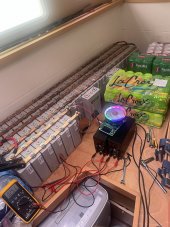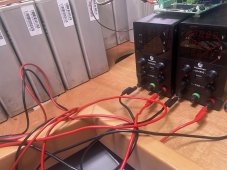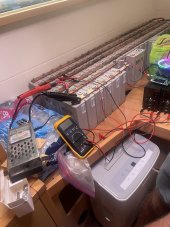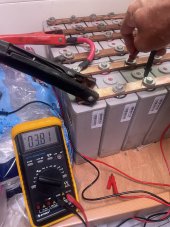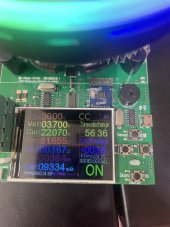I think what @noenegdod and I are agreeing on is that you don't need to get it all the ways to 0A.
Once fully charged, they will "settle" down to something like 3.4V (depends on the cells), but are still fully charged. It isn't because of the internal resistance. The self-discharge of something like 1-2% per month is due to internal resistance
They don’t settle at 3.64v
They continually drop at a steady rate.
Here is the results of my “Standing Resistance Test”, after charging the batteries for a week to 3.65v until the Amps read 0.000A, and then simply disconnecting them all from each other and recording the results:
DATE and TIME results taken in order:
12AUG 15:30
13AUG 11:20
13AUG 15:40
14AUG 09:30
16AUG 8:10
16AUG 15:15
17AUG 08:45
18AUG 09:15
18AUG 15:50
19AUG 09:50
20AUG 08:50
20AUG 15:15
21AUG 09:30
23AUG 08:15
First I list the battery number: (in this example Cell number #16 was first reading at 12AUG at 15:30 was 3.64v) *I didn’t start recording 3 digits until the 3rd reading.
16 3.64 3.64 3.64 3.639 3.632 3.630 3.628 3.624 3.623 3.621 3.618 3.616 3.614 3.608
36 3.64 3.64 3.637 3.632 3.620 3.617 3.614 3.608 3.606 3.602 3.598 3.596 3.593 3.584
32 3.64 3.64 3.639 3.636 3.627 3.625 3.622 3.617 3.616 3.613 3.609 3.608 3.606 3.598
4 3.64 3.64 3.638 3.634 3.624 3.623 3.620 3.615 3.614 3.611 3.608 3.607 3.604 3.598
5 3.64 3.64 3.638 3.634 3.624 3.623 3.620 3.615 3.614 3.611 3.608 3.606 3.604 3.598
15 3.64 3.64 3.637 3.632 3.622 3.620 3.617 3.612 3.611 3.608 3.604 3.603 3.600 3.594
10 3.64 3.64 3.637 3.633 3.623 3.621 3.618 3.613 3.612 3.609 3.606 3.604 3.602 3.596
6 3.64 3.64 3.638 3.634 3.625 3.623 3.621 3.616 3.615 3.612 3.608 3.608 3.605 3.599
34 3.64 3.64 3.637 3.634 3.624 3.622 3.619 3.615 3.614 3.611 3.608 3.606 3.604 3.598
31 3.64 3.64 3.635 3.630 3.619 3.617 3.614 3.608 3.608 3.604 3.600 3.599 3.596 3.590
22 3.64 3.64 3.637 3.633 3.623 3.622 3.619 3.614 3.614 3.610 3.607 3.606 3.604 3.597
46 3.64 3.64 3.639 3.635 3.625 3.623 3.620 3.614 3.614 3.610 3.606 3.604 3.602 3.594
1 3.64 3.64 3.638 3.635 3.625 3.623 3.621 3.616 3.615 3.612 3.609 3.608 3.605 3.599
18 3.64 3.64 3.638 3.634 3.624 3.623 3.620 3.616 3.614 3.612 3.608 3.607 3.604 3.598
12 3.64 3.64 3.637 3.633 3.623 3.622 3.619 3.614 3.614 3.611 3.607 3.606 3.604 3.598
24 3.64 3.64 3.639 3.635 3.627 3.625 3.623 3.618 3.618 3.615 3.612 3.611 3.609 3.603
3 3.64 3.64 3.637 3.634 3.624 3.622 3.619 3.614 3.613 3.610 3.606 3.605 3.603 3.596
2 3.64 3.64 3.637 3.633 3.623 3.621 3.619 3.614 3.613 3.610 3.607 3.605 3.603 3.596
23 3.64 3.64 3.638 3.634 3.625 3.623 3.621 3.616 3.616 3.613 3.609 3.608 3.606 3.600
47 3.64 3.64 3.636 3.631 3.621 3.619 3.616 3.611 3.610 3.606 3.603 3.602 3.599 3.592
40 3.64 3.64 3.638 3.633 3.624 3.622 3.620 3.614 3.614 3.610 3.607 3.606 3.603 3.597
7 3.64 3.64 3.637 3.633 3.622 3.620 3.618 3.612 3.612 3.608 3.604 3.603 3.601 3.594
39 3.64 3.64 3.636 3.632 3.621 3.619 3.616 3.610 3.609 3.606 3.602 3.600 3.598 3.591
14 3.64 3.64 3.637 3.632 3.622 3.620 3.617 3.612 3.611 3.608 3.604 3.603 3.600 3.594
28 3.64 3.64 3.638 3.635 3.626 3.625 3.622 3.618 3.617 3.614 3.611 3.610 3.608 3.602
37 3.64 3.64 3.64 3.639 3.632 3.631 3.629 3.625 3.625 3.623 3.620 3.619 3.617 3.612
35 3.64 3.64 3.639 3.636 3.627 3.626 3.623 3.619 3.618 3.616 3.612 3.612 3.609 3.604
29 3.64 3.64 3.639 3.637 3.629 3.627 3.625 3.621 3.620 3.618 3.614 3.614 3.611 3.606
30 3.64 3.64 3.634 3.629 3.618 3.616 3.612 3.607 3.606 3.602 3.598 3.597 3.595 3.588
17 3.64 3.64 3.637 3.632 3.622 3.620 3.617 3.612 3.611 3.608 3.604 3.603 3.601 3.594
39A 3.64 3.63 3.626 3.618 3.600 3.597 3.592 3.584 3.582 3.578 3.572 3.629 3.645 3.614
40A 3.64 3.63 3.624 3.615 3.595 3.592 3.587 3.579 3.577 3.572 3.567 3.47 2.960 3.641
45 3.64 3.64 3.635 3.630 3.619 3.617 3.614 3.609 3.608 3.605 3.601 3.600 3.597 3.590
13 3.64 3.64 3.636 3.631 3.620 3.618 3.614 3.609 3.608 3.605 3.601 3.600 3.598 3.590
25 3.64 3.64 3.638 3.634 3.625 3.623 3.621 3.617 3.616 3.613 3.610 3.609 3.607 3.601
38 3.64 3.64 3.639 3.636 3.627 3.626 3.623 3.619 3.618 3.616 3.613 3.612 3.610 3.604
26 3.64 3.64 3.637 3.633 3.623 3.622 3.619 3.614 3.614 3.611 3.607 3.607 3.604 3.598
48 3.64 3.64 3.64 3.638 3.629 3.628 3.626 3.622 3.621 3.618 3.615 3.614 3.612 3.606
19 3.64 3.64 3.637 3.633 3.623 3.621 3.618 3.614 3.612 3.610 3.606 3.605 3.602 3.596
43 3.64 3.64 3.636 3.632 3.621 3.619 3.616 3.611 3.610 3.607 3.603 3.603 3.600 3.593
11 3.64 3.64 3.637 3.633 3.623 3.621 3.619 3.614 3.613 3.610 3.606 3.606 3.603 3.596
44 3.64 3.64 3.637 3.632 3.621 3.620 3.617 3.612 3.611 3.608 3.604 3.603 3.600 3.594
8 3.64 3.64 3.637 3.633 3.623 3.621 3.619 3.614 3.612 3.610 3.606 3.606 3.603 3.596
42 3.64 3.64 3.638 3.634 3.625 3.623 3.620 3.615 3.614 3.611 3.608 3.607 3.604 3.598
33 3.64 3.64 3.639 3.636 3.627 3.625 3.623 3.619 3.618 3.615 3.612 3.612 3.609 3.603
27 3.64 3.64 3.639 3.635 3.626 3.625 3.623 3.618 3.618 3.615 3.612 3.612 3.609 3.603
41 3.64 3.64 3.639 3.635 3.626 3.625 3.622 3.618 3.617 3.614 3.611 3.610 3.608 3.602
9 3.64 3.64 3.639 3.636 3.627 3.625 3.623 3.619 3.618 3.616 3.613 3.612 3.610 3.603
21 3.64 3.64 3.639 3.635 3.627 3.625 3.623 3.618 3.618 3.615 3.612 3.611 3.609 3.603
20 3.64 3.64 3.639 3.636 3.627 3.626 3.624 3.619 3.618 3.616 3.613 3.612 3.609 3.604



